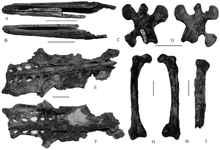Plotopteridae
| Plotopterids Temporal range: Eocene – Miocene | |
|---|---|
 | |
| Copepteryx | |
| Scientific classification | |
| Kingdom: | Animalia |
| Phylum: | Chordata |
| Class: | Aves |
| Order: | Pelecaniformes |
| Family: | Plotopteridae Howard, 1969 |
| Genera | |
|
Copepteryx | |
Plotopteridae is the name of an extinct family of flightless seabirds from the order Pelecaniformes. Related to the gannets and boobies, they exhibited remarkable convergent evolution with the penguins, particularly with the now extinct giant penguins. That they lived in the North Pacific, the other side of the world from the penguins, has led to them being described at times as the Northern Hemisphere's penguins, although one new theory suggests that this group is a link between the penguins and the Pelecaniformes. Their fossils have been found in California, Washington and Japan. They ranged in size from that of a large cormorant (such as a Brandt's Cormorant), to being 2 m long. They had shortened wings designed for underwater wing-propelled pursuit diving (like penguins or the now extinct Great Auk), a body skeleton similar to that of the darter and the skull similar to that of a sulid.

The earliest known Plotopteridae species, Phocavis maritimus lived in the mid-Eocene, but most of the known species lived in the early and mid-Miocene, after which it appears they went extinct. That they went extinct at the same time as the giant penguins of the Southern Hemisphere, which also coincided with the radiation of the seals and dolphins, has led to speculation that the expansion of marine mammals was responsible for the extinction of the Plotopteridae.
References
- Howard, H. (1969). "A new avian fossil from Kern County, California". Condor 71: 68–69. doi:10.2307/1366050.
- Olson, Storrs L.; Hasegawa, Yoshikazu; Hasegawa (1979). "Fossil Counterparts of Giant Penguins from the North Pacific". Science 206 (4419): 688–689. Bibcode:1979Sci...206..688O. doi:10.1126/science.206.4419.688.
- Olson, Storrs L. & Hasegawa, Yoshikazu (1996). "A new genus and two new species of gigantic Plotopteridae from Japan (Aves: Pelecaniformes)". J. Vert. Paleontol. 16 (4): 742–751. doi:10.1080/02724634.1996.10011362.
- Schreiber, E.A. & Burger, J. (2001). Biology of Marine Birds. ISBN 0-8493-9882-7.
- Mayr, Gerald (2005). "Tertiary plotopterids (Aves, Plotopteridae) and a novel hypothesis on the phylogenetic relationships of penguins (Spheniscidae)". Journal of Zoological Systematics 43 (1): 67–71.